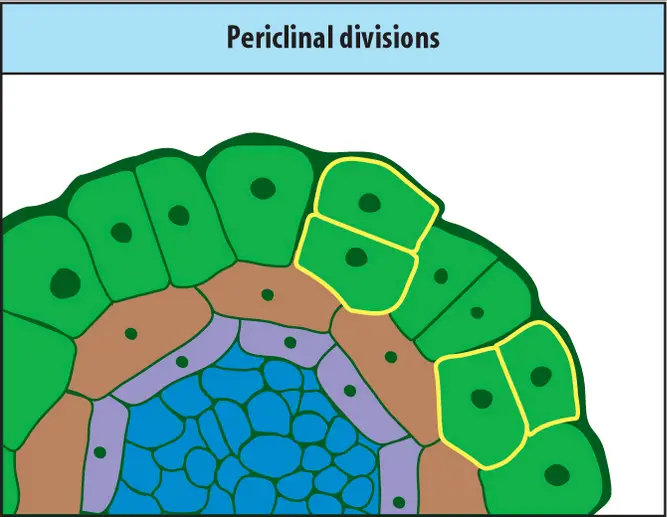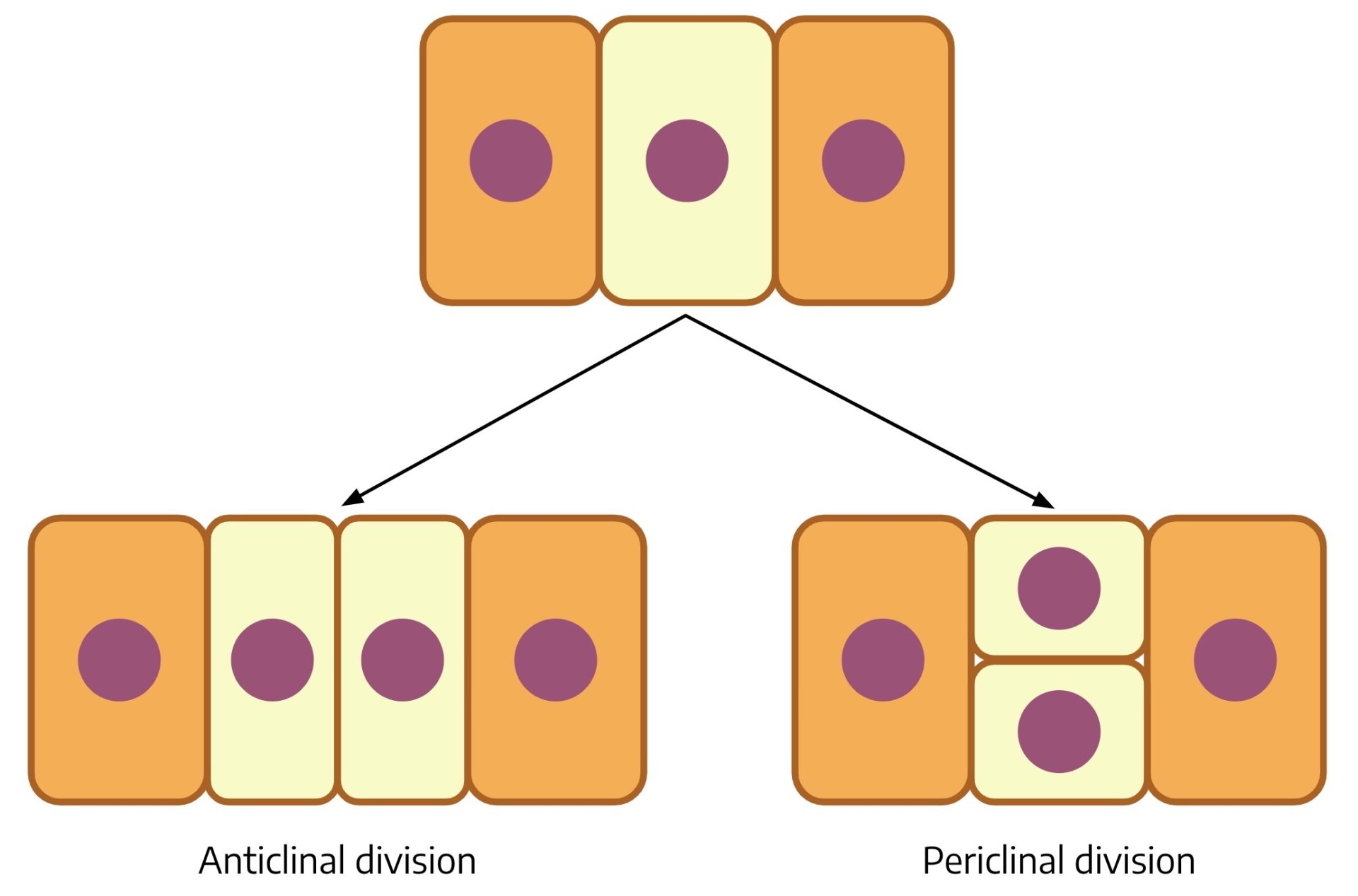Cell division is a fundamental biological process that dictates growth, reproduction, and regeneration across various organisms. Two specific types of cell division, anticlinal and periclinal, play pivotal roles particularly in plant biology, influencing everything from the basic structure to the overall morphology of plants. These divisions, although less known outside scientific circles, provide insights into how plants grow and adapt to their environments.
Anticlinal division occurs perpendicular to the surface of the plant, leading to an increase in surface area, which is critical for expanding the girth of organs such as stems and roots. Periclinal division, on the other hand, happens parallel to the surface, contributing to the growth in thickness of the plant’s organs. This strategic orientation of cell division directly impacts plant structure and function, reflecting a delicate balance of internal and external biological factors.
The distinction between anticlinal and periclinal division is not merely a topic of academic interest but also a crucial element in agricultural practices and botanical research. By understanding these processes, scientists and farmers can manipulate plant growth and development to optimize yield and efficiency in crop production.

Cell Division Basics
Definition and Significance
Cell division is the process by which a parent cell divides into two or more daughter cells. This fundamental biological function is essential for growth, repair, and reproduction in living organisms. In plants, cell division is pivotal for growth and development, enabling them to increase in size, repair damaged tissues, and reproduce. The mechanism of cell division varies among different organisms and cellular contexts, but it consistently serves as a cornerstone of biological continuity.
Types of Cell Division
In the realm of biology, there are several types of cell division, each serving distinct roles:
- Mitosis: Leads to the production of two daughter cells with identical genetic material as the parent, pivotal for growth and tissue repair.
- Meiosis: Results in four daughter cells, each with half the genetic material of the parent, crucial for sexual reproduction.
- Binary Fission: Common in prokaryotic organisms, where the cell divides into two equal parts.
Anticlinal Division
Definition
In the context of plant biology, anticlinal division refers to cell division oriented perpendicular to the surface of a plant tissue. This orientation results in cells dividing side-to-side, facilitating the expansion of the plant organ outward.
Role in Plant Growth
Anticlinal division plays a crucial role in increasing the surface area of plant organs such as stems and roots. This type of growth is vital for:
- Expanding the girth of stems and roots, allowing for increased support and nutrient absorption.
- Enhancing the photosynthetic capacity of leaves by increasing their spread.
Examples in Nature
Observations of anticlinal division can be found in:
- Tree Trunks: The radial expansion of tree trunks is largely due to anticlinal division in the cambial layer.
- Root Thickening: Roots thicken primarily through anticlinal division, which allows them to explore and exploit soil resources more effectively.
Periclinal Division
Definition
Periclinal division is characterized by cell division that is parallel to the surface of the plant organ. This orientation promotes an increase in thickness or depth, contributing to the organ’s internal growth.
Biological Functions
Periclinal division is essential for:
- Building organ thickness: Critical for the structural stability and functionality of plant organs.
- Forming distinct tissue layers: Necessary for the differentiation of tissues within leaves, stems, and roots.
Common Occurrences
Periclinal division is commonly observed in:
- Leaf development: Contributing to the layering of cells that form various tissues within the leaf.
- Bark formation: Involving the periclinal division in the cork cambium, leading to protective bark layers.
Comparative Analysis
Structural Differences
The structural differences between anticlinal and periclinal divisions are evident in their orientations:
- Anticlinal: Divisions expand the organ laterally.
- Periclinal: Divisions increase the depth or internal layers of the organ.
Functional Contrasts
While both types of division are integral to plant growth, they serve different functional purposes:
- Anticlinal division is primarily involved in widening and expanding the external parts of an organ.
- Periclinal division focuses on thickening and strengthening the internal structures.
Impact on Organism Development
The interplay between anticlinal and periclinal divisions has a profound impact on the overall development of an organism by:
- Determining plant shape and size: The balance between these two types of divisions influences the physical form and dimensions of the plant.
- Adapting to environmental factors: Plants may favor one type of division over another based on environmental conditions such as light availability, space, and nutrient distribution.

Role in Plant Morphology
Influence on Tissue Layers
Anticlinal and periclinal divisions profoundly impact the arrangement and development of tissue layers within plant organs. The orientation of cell division dictates how tissues are structured, which in turn influences their function and efficiency.
- Anticlinal division contributes to the creation of radial layers, facilitating the expansion of organs such as roots and stems outward.
- Periclinal division is crucial for adding layers along the axis of the organ, enhancing depth and complexity in structures like leaves and flowers.
These processes ensure that plants develop robust and differentiated tissues necessary for various functions, from nutrient transport to photosynthesis.
Contribution to Plant Shape and Size
The physical form and size of plants are direct outcomes of the patterns and rates of cell division:
- Plants with dominant anticlinal growth tend to be wider and have more girth, which can contribute to greater stability and resource uptake.
- Those that exhibit more periclinal growth often show increased height or thickness, which might be beneficial in competitive environments where light is a limiting factor.
This dynamic between the two types of cell division allows plants to adapt their shapes to their environmental conditions, optimizing their chances for survival and reproduction.
Applications in Agriculture
Enhancing Crop Yield
Understanding and manipulating anticlinal and periclinal divisions can lead to significant improvements in agricultural productivity:
- Optimization of plant architecture: By controlling the balance between anticlinal and periclinal divisions, farmers can cultivate crops that utilize space and resources more efficiently.
- Increased biomass production: Targeted enhancement of anticlinal division in crop roots and stems can lead to larger plants, potentially increasing yield per plant.
These strategies are particularly valuable in high-density planting environments where space is at a premium.
Genetic Modification Considerations
The role of genetic engineering in modifying cell division patterns offers promising avenues for crop improvement:
- Gene editing technologies such as CRISPR can be used to tweak the genes responsible for anticlinal and periclinal divisions, tailoring plant growth to specific agricultural needs.
- Transgenic approaches might introduce novel traits that alter division patterns, thereby enabling plants to withstand environmental stresses better or make better use of nutrients.
These genetic modifications require careful consideration of ecological impacts and regulatory frameworks but hold considerable potential for the future of farming.
Research Trends
Recent Studies and Findings
Recent research in plant biology has shed light on the molecular mechanisms governing anticlinal and periclinal divisions. Studies often focus on:
- Regulatory pathways that control the switch between anticlinal and periclinal orientations, revealing targets for genetic manipulation.
- Environmental influences on cell division patterns, such as how light, water, and nutrient availability can alter growth trajectories.
These findings not only deepen our understanding of plant development but also provide practical insights for agriculture.
Future Directions in Cellular Biology
Looking ahead, the study of cell division in plants is poised to embrace several promising directions:
- Integration of cellular biology with environmental science: Understanding how cell division responds to climate change and environmental stressors is becoming increasingly important.
- Development of smart crops: Leveraging genetic insights to create crops that automatically adjust their growth patterns in response to environmental conditions could revolutionize agriculture.
Frequently Asked Questions
What is Anticlinal Division?
Anticlinal division is a type of cell division in plants where cells divide in a direction perpendicular to the surface of an organ. This process leads to an increase in the surface area, facilitating the lateral expansion of plant tissues and organs.
How Does Periclinal Division Differ?
Periclinal division involves cell division parallel to the surface of the plant organ. This orientation promotes the thickening of tissues and is crucial for the vertical growth of plant structures, enhancing their structural integrity and function.
Why are These Divisions Important?
Understanding anticlinal and periclinal divisions is vital for botany and agriculture. These processes affect plant morphology, influencing how efficiently a plant can grow and utilize resources, which in turn impacts agricultural productivity and ecological sustainability.
Can These Divisions be Manipulated?
Yes, through various agricultural and genetic techniques, it’s possible to manipulate these cell divisions to favor certain growth patterns. This manipulation can lead to improved crop yields and resilience, making it a significant area of research in crop science.
Conclusion
The differentiation between anticlinal and periclinal divisions underscores the complexity and adaptability of plant life. These cellular processes not only determine the physical attributes of plants but also their capability to thrive in diverse environments. As we continue to uncover the intricacies of these divisions, the potential to enhance agricultural practices grows, promising a future where plant resources are optimized sustainably and efficiently.
In conclusion, while the principles of anticlinal and periclinal division might seem esoteric, they are foundational to advancing our understanding of plant biology. This knowledge not only enriches our scientific community but also equips us with the tools to innovate in the fields of agriculture, environmental science, and biotechnology.

